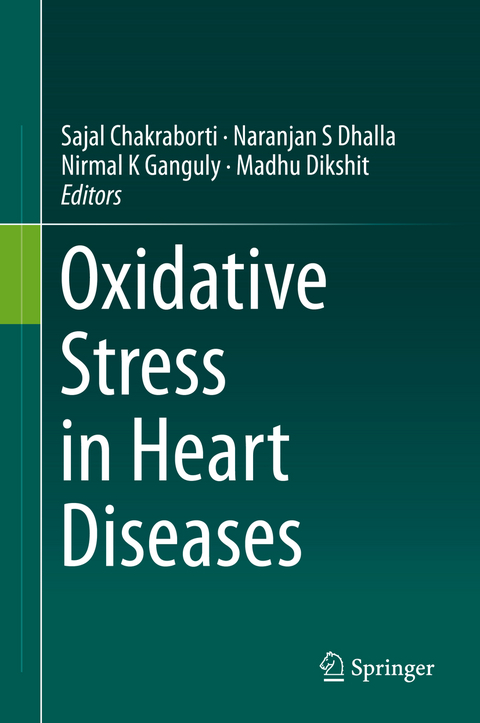
Oxidative Stress in Heart Diseases
Springer Verlag, Singapore
978-981-13-8272-7 (ISBN)
This book bridges the gap between fundamental and translational research in the area of heart disease. It describes a multidisciplinary approach, and demonstrates biochemical mechanisms associated with dysregulation of redox signaling, which leads heart disease. Presenting recent studies on improved forms of ROS scavenging enzymes; specific inhibitors for different ROS generating enzymes; and oxidant induced signaling pathways and their antagonists that allow subtle modulation of redox signaling, it also discusses the spatial and temporal aspects of oxidative stress in the cardiovascular system, which are of vital importance in developing better strategies for treating heart disease. Each chapter offers researchers valuable insights into identifying targets for drug development for different types of heart disease.
Dr. Sajal Chakraborti (e.mail: saj_chakra@rediffmail.com) is a senior Professor of Biochemistry at the University of Kalyani, West Bengal, India. His research mainly focuses on the role of vasoactive agents in regulating vascular tone under oxidant and calcium signaling phenomena. He has been engaged in biochemistry teaching and research for the past 40 years. Dr. Naranjan S Dhalla (e.mail: NSDhalla@sbrc.ca) is a distinguished Professor at the University of Manitoba, Winnnipeg, Canada. His expertise includes the subcellular and molecular basis of heart function in health and disease. He has been involved in multidisciplinary research and education to promote the scientific basis of cardiology for over 50 years. Dr. Madhu Dixit (e.mail: rmadhudikshit@gmail.com) is a National Chair Fellow of the Translational Health Science and Technology Institute, Faridabad, Haryana, India. She has contributed to the general area of biochemical pharmacology and has a special interest in cardiovascular pharmacology, particularly redox biology. Dr. Dikshit has been involved in research, especially drug discovery and development, for over 40 years. Dr. Nirmal K Gangul, (e-mail: ganguly1nk@gmail.com), is a distinguished biotechnologist and former Director General of the Indian Council of Medical Research (ICMR), and is associated with Global Health Strategies, New Delhi, India. He was presented with the Padma Bhushan Award in the field of Medicine by the President of India in 2008.
I. Role of Oxidative Stress in Heart Diseases.- 1. J.L Johnson. Laboratory of cardiovascular pathology, School of Clinical Sciences, University of Bristol, Bristol. UK.- 2. M.A.Srivastava, Department of Physiology, McGill University, Canada.- 3. P. Balakumar. Pharmacology Unit, AIMST University, Semeling 08100 Bedong, Kedah Darul Aman, Malaysia.- 4. K. B Pasumarthi. Department of Pharmacology, Dalhousie University, Halifax, Nova Scotia, Canada.- 5. B. Turan. Department of Biophysics, Ankara University, Faculty of Medicine, Ankara,Turkey.- 6. Z. Xie. Marshall Institute of Interdisciplinary Research, Marshall University, Huntington,WV, USA.- 7. T. L. Haas. Angiogenesis Research Group, School of Health Sciences, York University,Toronto, Canada.- 8. A. Kukol. School of Life and Medical Sciences, University of Hertfordshire, Hatfield, UK.- 9. N.S.Dhalla, Cardiovascular Research Institute, University of Manitoba, Winnipeg, Canada.- 10. A.K.Srivastava. Cell Signalling laboratory, McGill University, Canada.- 11. S.Chakraborti, University of Kalyani, Kalyani 741235, West Bengal, India.- 12. S.Goswami, School of Life Sciences, Jawaharlal Nehru University, New Delhi, India.- 13. C.C.Kartha, Rajiv Gandhi Institute of Biotechnology, Thiruvanatapuram, India.- 14. S.K.Malick, Department of Pharmacology. AIIMS, New Delhi, India.- 15. S.Chatterjee, Anna University, Chennai, India.- 16. N.Mahapatra, IIT-Madras, Chennai, India.- 17. R. Bhunya, Department of Biochemistry and Biophysicvs, University of kalyani, West Bengal, India.- 18. S.Nandi, North Est Hill University, Meghalaya, India.- 19. N.K.Ganguly, Sir gangaram Hospital, New Delhi.- 20. M.Dixit, CSIR-CDR, -Lucknow, India.- 21. A.D.Abell, University of Adelaide, Australia.- 22. Chava Kimchi Sarfaty, Centre for Biologics Evaluation and Research, Foodand Drug Administration, Bethesda, Maryland, USA.- 23. B. Furhman, Technion Faculty of Medicine and Ramban Medical Center, Hiafa, Israel.- 24. R.F.Gerlach, Department of Physiology, University of Sao Paulo, Brazil.- 25.T.L.Haas, School of Kinesiology and Health Sciences, York University, Toronto, Canada.- 26. B. Mittal, Department of Genetics. Sanjay Gandhi Post Graduate Institute of Medical Sciences, Lucknow, Uttap Pradesh, India.- 27. Richard Schulz, Department of Pedfiatrics, University of Alberta, Canada.- 28. Bodh J Jugdutt, Mackenzie Haeth Sciences Centre, Division of Cardiology, University of Alberta, Canada.- 29. Vibha Rani, Jaypee Institute of Information Technology, Noida, Uttar Pradesh, India .- 34. Veena Dhawan, Department of Experimental Medicine and Biotechnology,PGIMER,Chandigarh, India.- 30. Surekha Rani, Department of Genetics, Osmania University, Hyderabad, Telengana State, India.
| Erscheinungsdatum | 30.04.2019 |
|---|---|
| Zusatzinfo | 66 Illustrations, black and white; XIII, 596 p. 66 illus. |
| Verlagsort | Singapore |
| Sprache | englisch |
| Maße | 155 x 235 mm |
| Themenwelt | Medizinische Fachgebiete ► Innere Medizin ► Kardiologie / Angiologie |
| Naturwissenschaften ► Biologie ► Biochemie | |
| Naturwissenschaften ► Biologie ► Mikrobiologie / Immunologie | |
| Naturwissenschaften ► Biologie ► Zellbiologie | |
| Schlagworte | Antioxidant • Cardiovascular Disease • Free Radicals • Heart Diseases • Oxidant • Oxidative stress • redox signalling |
| ISBN-10 | 981-13-8272-7 / 9811382727 |
| ISBN-13 | 978-981-13-8272-7 / 9789811382727 |
| Zustand | Neuware |
| Haben Sie eine Frage zum Produkt? |
aus dem Bereich


